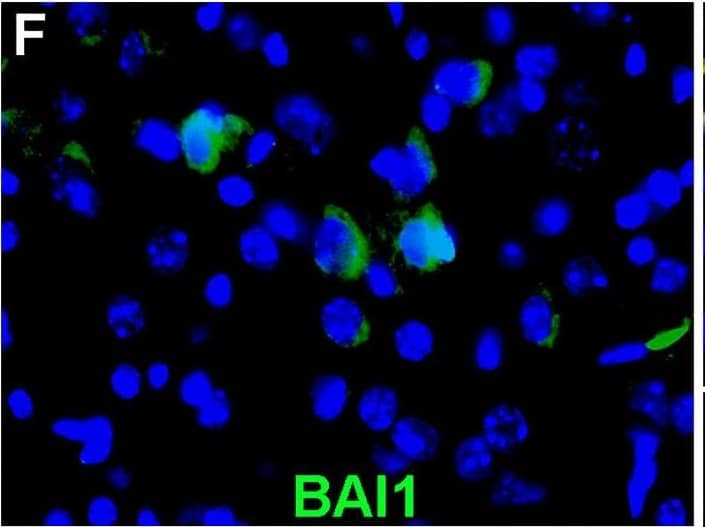Human BAI1 Antibody Summary
Met1-Thr879
Accession # O14514
Applications
Please Note: Optimal dilutions should be determined by each laboratory for each application. General Protocols are available in the Technical Information section on our website.
Scientific Data
 View Larger
View Larger
Detection of Human BAI1 by Immunohistochemistry Localization of BAI1, Noggin, Iba1, NeuN and GFAP in the mouse brain.Tissue sections from the day-10 mouse brain were stained with hematoxylin and eosin (sagittal sections A and D; coronal sections B and C) or double labeled with the G8 and the R&D BAI1 mAbs, or G8 and antibodies to Iba1, NeuN or GFAP. The areas within the boxes of the H&E stained sections are shown at high magnification in the fluorescence photomicrographs. The colors of the fluorescent secondary antibodies are indicated in the unmerged photographs (E, F, H and I). Nuclei were stained with Hoechst dye. Overlap of red and green, when present, appears yellow in merged images (G, J, K, L and M). The G8 and BAI1 mAbs labeled the same subpopulation of cells in the hippocampal formation (box in A; E-G). The Noggin and BAI1 antibodies also bound to the same cells in the glomerular layer of the olfactory bulb (box in B; H-J). G8 did not co-localize with Iba1 (K, from box in A), NeuN (L from lower box in C) or GFAP (M from box in D). Minimal fluorescence was observed with the anti-IgM and anti-IgG (inset in G) or the anti-goat and anti-IgG (inset in J) secondary antibodies. Bar = 270 μM in A-D and 9 μM in E-M. Image collected and cropped by CiteAb from the following open publication (https://pubmed.ncbi.nlm.nih.gov/32614850), licensed under a CC-BY license. Not internally tested by R&D Systems.
Reconstitution Calculator
Preparation and Storage
- 12 months from date of receipt, -20 to -70 °C as supplied.
- 1 month, 2 to 8 °C under sterile conditions after reconstitution.
- 6 months, -20 to -70 °C under sterile conditions after reconstitution.
Background: BAI1
Brain Angiogenesis Inhibitor 1 (BAI1) is a 170 kDa 7-transmembrane domain G protein-coupled receptor (GPCR) that has a large N-terminal extracellular region with an RGD motif, five thrombospondin type I repeats, and a juxtamembrane GPS (GPCR proteolytic cleavage site) (1). Within the extracellular domain (ECD) up to the GPS (amino acids 31‑879), mature human BAI1 shares 94% amino acid sequence identity with mouse and rat BAI1. BAI1 is preferentially expressed on brain neurons but also is found on astrocytes and macrophages and in the pancreas, stomach, and colon (1‑8). BAI1 can be cleaved within the GPS to release a 120 kDa fragment termed Vasculostatin which corresponds to nearly the entire N-terminal ECD (9). Generation of additional soluble fragments suggests the cleavage of BAI1 at multiple sites (9, 10). BAI1 fragments interact with Integrin alpha V beta 5 or CD36 on microvascular endothelial cells to inhibit cell proliferation and migration (10, 11). Overexpression of BAI1 in glioblastoma or pancreatic adenocarcinoma cells inhibits their tumorigenicity and the development of tumor-associated neovascularization (6, 12). Fragments of the ECD, including Vasculostatin, also suppress in vivo angiogenesis and tumor growth (1, 9, 11). BAI1 is down‑regulated in glioblastoma, carcinomas of the pancreas, colon, and stomach and also in experimental ischemia (2, 4, 6‑8). Its expression is inversely correlated with tumor vascularity in colorectal and pulmonary carcinomas (8, 13). On macrophages and astrocytes, BAI1 mediates the phagocytosis of apoptotic cells through recognition of cell surface phosphatidylserine (5).
- Nishimori, H. et al. (1997) Oncogene 15:2145.
- Koh, J.T. et al. (2001) Brain Res. Mol. Brain Res. 87:223.
- Mori, K. et al. (2002) Neurosci. Res. 43:69.
- Kaur, B. et al. (2003) Am. J. Pathol. 162:19.
- Park, D. et al. (2007) Nature 450:430.
- Duda, D.G. et al. (2002) Br. J. Cancer 86:490.
- Lee, J.H. et al. (2001) Int. J. Oncol. 18:355.
- Fukushima, Y. et al. (1998) Int. J. Oncol. 13:967.
- Kaur, B. et al. (2005) Oncogene 24:3632.
- Koh, J.T. et al. (2004) Exp. Cell Res. 294:172.
- Kaur, B. et al. (2009) Cancer Res. 69:1212.
- Kang, X. et al. (2006) Cancer Gene Ther. 13:385.
- Hatanaka, H. et al. (2000) Int. J. Mol. Med. 5:181.
Product Datasheets
Citation for Human BAI1 Antibody
R&D Systems personnel manually curate a database that contains references using R&D Systems products. The data collected includes not only links to publications in PubMed, but also provides information about sample types, species, and experimental conditions.
1 Citation: Showing 1 - 1
-
Brain-specific angiogenesis inhibitor 1 is expressed in the Myo/Nog cell lineage
Authors: J Gerhart, J Bowers, L Gugerty, C Gerhart, M Martin, F Abdalla, A Bravo-Nuev, JT Sullivan, R Rimkunas, A Albertus, L Casta, L Getts, R Getts, M George-Wei
PLoS ONE, 2020-07-02;15(7):e0234792.
Species: Human, Mouse, Rabbit, Rat
Sample Types: Whole Tissue
Applications: IHC
FAQs
No product specific FAQs exist for this product, however you may
View all Antibody FAQsReviews for Human BAI1 Antibody
There are currently no reviews for this product. Be the first to review Human BAI1 Antibody and earn rewards!
Have you used Human BAI1 Antibody?
Submit a review and receive an Amazon gift card.
$25/€18/£15/$25CAN/¥75 Yuan/¥2500 Yen for a review with an image
$10/€7/£6/$10 CAD/¥70 Yuan/¥1110 Yen for a review without an image
